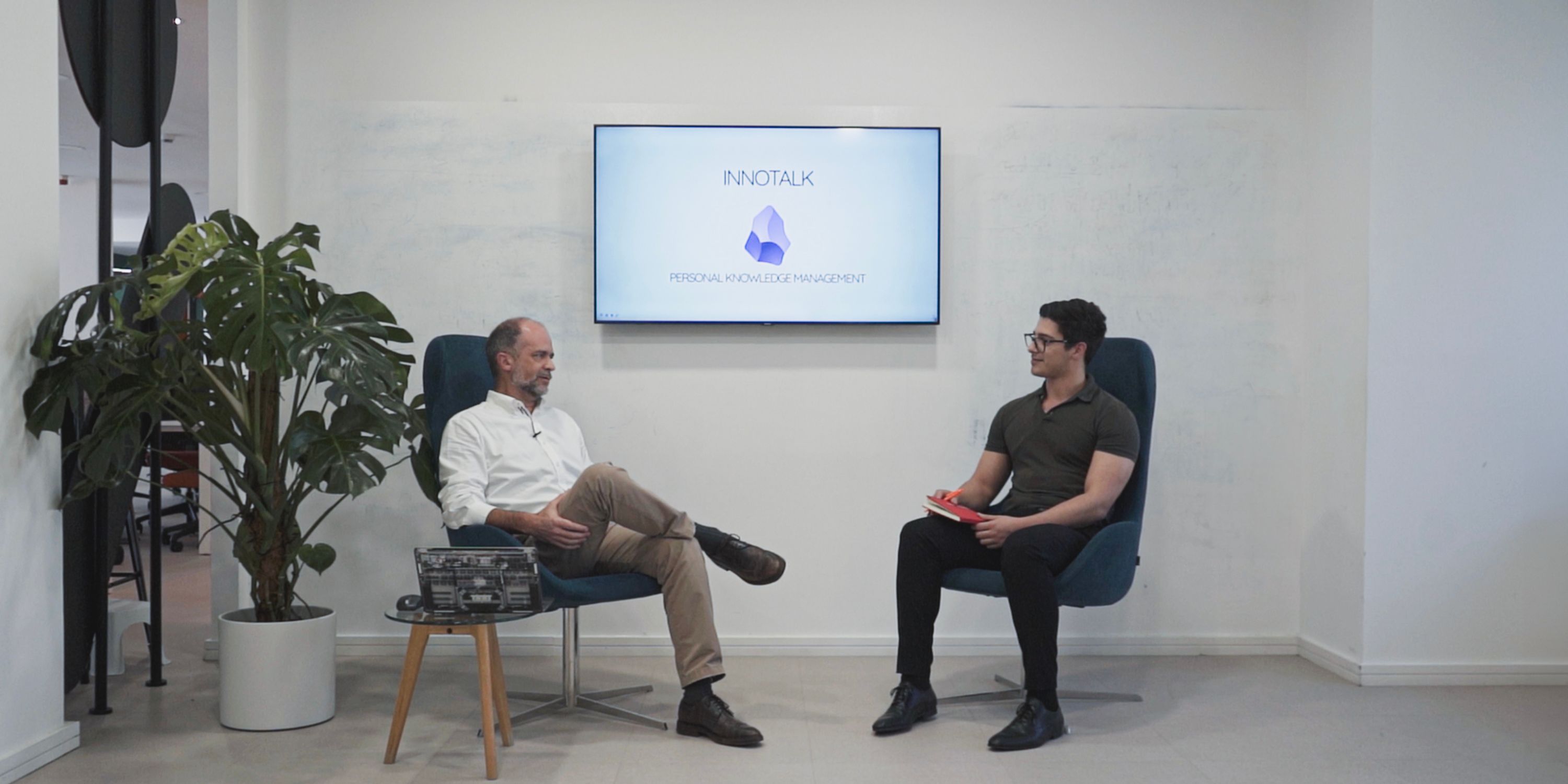A Product Owner is the guardian of the product vision and driving efficiency in project development.
Product Owner is a fundamental role in development projects. In the first edition of InnoTech’s InnoTalks we delved into the Product Owner role and aimed at explaining the importance of a Product Owner and how their processes can maximize project development efficiently. In this article we will explore what it is to be a Product Owner, and delve into some of the insights shared by Patricia Toda Marques and Victor Azevedo, Product Owner’s at InnoTech.
What is a Product Owner?
The role of the Product Owner is fundamental in product development. They are responsible for defining the product’s vision, prioritizing the work of the development team and ensuring that the product meets the customers’ needs. The Project Owner works closely with all stakeholders to understand their requirements and ensure that the product is developed according to their expectations. The PO is also responsible for keeping the product backlog up to date and ensuring that the team is always working on the most important tasks for the product’s success. In short, the Product Owner is the guardian of the product vision and plays a crucial role in the success of the project.
In the words of Patricia Toda Marques, Product Owner at InnoTech: “The fundamental role of the PO, the most important thing is for them to know the product they are creating, evolving. The most important measure for achieving objectives is to be aware of the product and the customer’s needs, to make everything contribute to the evolution of the product. Well-defined objectives are a good way of managing objectives.”
What are the Challenges of being a Product Owner?
There are some challenges that come with the Product Owner role. For Victor Azevedo, “managing the stakeholders expectations is the most important element for the PO role”. When outlining the product development, or rather as Patricia referred to it, evolution, some challenges might arise, such as:
- Backlog Prioritization: Product Owners often struggle with prioritizing items in the product backlog due to competing interests, limited resources, and changing market dynamics. They must balance short-term needs with long-term goals to ensure the backlog reflects the most valuable features for the users and the business.
- Understanding Customer Needs: It can be challenging for POs to accurately interpret and prioritize customer needs amidst diverse user feedback and varying stakeholder interests. Product Owners must continuously gather and analyze user data, conduct market research, and solicit feedback to ensure the product meets the evolving needs of its users.
- Balancing Time and Quality: Product Owners face the constant dilemma of delivering high-quality features within tight deadlines. Balancing time constraints with the need for thorough testing and refinement is crucial to avoid sacrificing quality for speed, or vice versa.
- Effective Communication: People in this role must effectively communicate with various stakeholders, including developers, designers, marketers, and executives, to align everyone around the product vision and goals. Clear and concise communication is essential for conveying priorities, managing expectations, and addressing concerns.
- Constantly Changing Requirements: In an agile environment, requirements are subject to change frequently based on market trends, user feedback, and business priorities. Product Owners must adapt quickly to these changes while minimizing disruptions to the development process and ensuring that the product remains aligned with the overall vision.
- Reconciling Interests: POs often need to navigate conflicting interests and priorities among stakeholders, such as balancing customer needs with business objectives or addressing competing demands from different departments. They must act as mediators to find common ground and make decisions that benefit the product and the organization as a whole.
- Strategic Alignment: To ensure that the product roadmap and feature prioritization align with the overall strategic goals of the organization, it requires a deep understanding of the company’s mission, vision, and market positioning, as well as the ability to make strategic trade-offs to maximize the product’s impact.
- Managing Expectations: POs face the challenge of managing stakeholders’ expectations regarding product features, timelines, and performance. They must set realistic expectations, communicate transparently about potential challenges, and proactively address any concerns to maintain trust and confidence in the product development process.
The Importance of Knowing your Product
The importance of knowing the product lies in several aspects that are crucial to successful development. Understanding the market in which the product is located, the target audience and benchmarking is essential for a more in-depth knowledge. Delivering product value is a multi-faceted process that requires a holistic understanding of customer needs, a strategic approach and the ability to adapt to change on an ongoing basis.
As Patricia stated, the Product Owner should always be able to answer the following questions: “What is the purpose of this product? What will it solve? Who is this product being developed for? What are the next steps – the roadmap – in the medium to long term?” As such there are steps Pos must take when studying the product:
1. Understanding Customer Needs: Recognizing and comprehending customer requirements lies at the core of delivering value. This entails actively engaging with users, gathering feedback, and conducting thorough research to ascertain their needs, preferences, and pain points.
2. Efficient Prioritization: Prioritizing features and tasks efficiently is crucial for maximizing product value. It involves assessing the relative importance and impact of different requirements, aligning them with strategic goals, and focusing resources on high-value initiatives that yield the most significant benefits for users and the business.
3. Measurement and Analysis: Continuous measurement and analysis are essential for evaluating product performance and identifying areas for improvement. By leveraging metrics, analytics, and user feedback, teams can gauge the effectiveness of features, track user engagement, and make data-driven decisions to optimize the product’s value over time.
4. Alignment with Strategic Objectives: Ensuring alignment with strategic objectives is imperative for delivering value that aligns with the organization’s overarching goals. Product initiatives should be closely tied to the company’s mission, vision, and long-term strategy to drive sustainable growth and competitive advantage.
5. Transparency in Communication: Maintaining transparency in communication fosters trust and collaboration among stakeholders. It involves openly sharing information about product development progress, decisions, and challenges, soliciting feedback, and keeping stakeholders informed about how their input influences product direction.
6. Flexibility to Change: Embracing flexibility and adaptability is essential in an environment characterized by constant change. Product teams must remain agile and responsive to evolving market trends, user needs, and competitive dynamics, adjusting their strategies and priorities accordingly to seize opportunities and mitigate risks.
7. Product Life Cycle: Managing the product life cycle involves navigating through different stages, from conception and development to launch, growth, and eventual maturity or sunsetting. Throughout each phase, product teams must continuously assess market dynamics, customer feedback, and technological advancements to ensure the product remains relevant and valuable to users.
Prioritizing Product Backlog
Prioritizing the product backlog is essential for effective project management and product development. Several strategies are commonly used to prioritize backlog items, including the MoSCoW method, Business Value (ROI), Complexity and Effort, and Impact and Frequency analysis.
However, integrating Objectives and Key Results (OKRs) can streamline this process and guide tactical decision-making more effectively. OKRs provide clear goals and measurable outcomes, aligning backlog priorities with broader strategic objectives. By incorporating OKRs into backlog prioritization, teams can ensure that their efforts are focused on delivering value that directly contributes to achieving organizational goals. This alignment enhances transparency, facilitates better decision-making, and ultimately drives more impactful outcomes for the product and the business.
InnoTalk: The Product Owner
In conclusion, the role of a Product Owner is pivotal in the success of development projects, acting as the guardian of the product vision and driving efficiency in project development.
Through effective management of stakeholder expectations, prioritization of backlog items, and alignment with strategic objectives, POs play a crucial role in ensuring that products meet customer needs and deliver value. However, POs face numerous challenges. As such, Product Owners must possess a deep understanding of the product, actively engage with customers, prioritize efficiently, measure and analyze performance, align with strategic goals, communicate transparently, remain flexible to change, and manage the product life cycle effectively.
Integrating Objectives and Key Results (OKRs) into backlog prioritization can further enhance the process, aligning backlog priorities with broader strategic objectives and driving more impactful outcomes for the product and the business. By addressing these challenges and leveraging effective strategies, POs can maximize project development efficiency and contribute to the overall success of their organizations.



